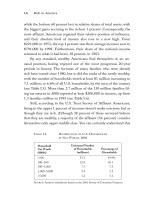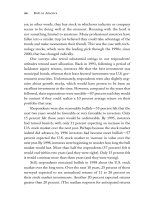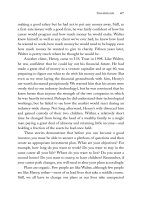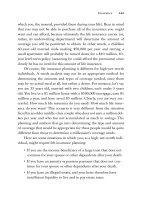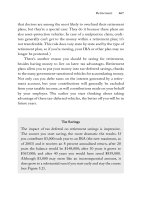Rich in America Secrets to Creating and Preserving Wealth PHẦN 7 pot
Bạn đang xem bản rút gọn của tài liệu. Xem và tải ngay bản đầy đủ của tài liệu tại đây (163.17 KB, 24 trang )
which you, the insured, provided them during your life). Bear in mind
that you may not be able to purchase all of the insurance you might
want and can afford, because ultimately the life insurance carrier (or,
rather, its underwriting department) will determine the amount of
coverage you will be permitted to obtain. In other words, a childless
60-year-old married male making $50,000 per year and renting a
small apartment will probably be turned down for a $10 million, 10-
year level-term policy (assuming he could afford the premiums) since
clearly he has no need for this amount of life insurance.
Of course, life insurance planning is different for high-net-worth
individuals. A needs analysis may not be an appropriate method for
determining the amounts and types of coverage needed, since there
may be no actual need at all, but rather a desire. For instance, let’s say
you are 35 years old, married with two children, each under 5 years
old. You live in a $1 million home with a $500,000 mortgage, earn $1
million a year, and have saved $3 million. Clearly, you are very suc-
cessful. How much life insurance do you need? How much life insur-
ance do you want? This scenario is very different from the situation
faced by an older middle-class couple who does not earn a million dol-
lars per year and who has not accumulated as much in savings. The
planning and analysis that go into determining the type and amount
of coverage that would be appropriate for these people would be quite
different from those to determine a millionaire’s coverage needs.
Here are some situations in which you, as a high-net-worth indi-
vidual, might require life insurance planning:
• If you are the income beneficiary of a large trust that does not
continue for your spouse or other dependents after your death.
• If you have an annuity or pension payment that does not con-
tinue for your spouse or other dependents after your death.
• If you have an illiquid estate, and your heirs therefore have
insufficient liquidity to live and to pay estate taxes.
Insurance 143
04 Chapter Maurer 6/20/03 5:12 PM Page 143
• If you have created a charitable trust and want to make up to
your heirs the assets that would otherwise pass to the charity
upon your death.
If you elect to purchase such insurance, it is essential to coordinate it with
your financial, retirement, and estate planning and gift-giving needs. You
must also coordinate the investment attributes of your life insurance with
your other investment activities. If these considerations sound compli-
cated, they are. You will need to consult with your financial planner and/or
a licensed life insurance agent. In particular, seek out someone with an
industry designation, such as a certified life underwriter (CLU). To sim-
plify the issue, it helps to understand the two broad categories of life
insurance: less permanent, non–cash value life insurance, and more per-
manent, cash value life insurance.
Less permanent, non–cash value life insurance comes in several
forms. One is known as term life insurance. This policy type provides
coverage, is generally thought of as temporary, and does not accumu-
late a cash value. Term coverage is generally priced according to the
cost per $1,000 of coverage (i.e., the cost of insurance, or COI) and
increases annually as the insured ages.Term life insurance policies may
be used to insure against the loss of life of a wage earner for a specific
time period connected with a specific financial obligation, such as the
30-year term of a home mortgage or a child’s four-year education.
Some variations on term coverage are:
Annual renewable term: This is a term policy type in which the con-
tract is renewable annually to some stated age, usually 75. Premiums
increase annually (as the insured ages). Once the insured reaches age
75, the policy is no longer in force and the coverage ends.
Level term: This is a term policy type in which premiums stay the
same for a specified period of time (e.g., 10, 20, or 30 years). The term
or duration for which a level premium policy may be contracted is a
144 Rich in America
04 Chapter Maurer 6/20/03 5:12 PM Page 144
function of the state in which the policy is purchased. Some states do
not allow level premium contracts of more than 20 years.
Convertible term: What’s known as conversion has become more of a
feature than an actual policy type. Both annual renewable term and
level premium term policies might come with a conversion feature that
allows the policy owner to convert the policy to the more permanent,
cash value variety, such as universal life or whole life (see below), but at
a higher annual premium within a certain number of years (such as for
the first 10 policy years, or until the insured reaches age 60).The major
benefit of this feature is that the policy may be converted without
additional (medical) underwriting, which is quite a significant benefit,
especially if the insured is ill.
More permanent, cash value life insurance also comes in several
forms:
Whole life: This policy type gets its name from the fact that policy pre-
miums are generally payable for your entire, or whole, life. Premiums
paid to the carrier are invested in the carrier’s general funds. The
investment return earned by the carrier, together with other factors
such as the past year’s mortality experience (i.e., how many covered
people have died), will help to determine if the carrier will have a sur-
plus of cash at year-end. If it does, it may declare a dividend (which is
actually a return of premium or principal). Dividends can be used by
policy owners in several ways, some of which include purchasing paid-
up additional insurance, applying them toward the payment of the
annual premium, or receiving them as cash.
Universal life: Universal life insurance is generally referred to as interest-
driven insurance. Premiums are paid to the carrier, which then deposits
the money in a separate accumulation account established for the specific
policy. The account is then both credited with interest and charged with
the cost of insurance, as well as mortality and expense charges, usually on
Insurance 145
04 Chapter Maurer 6/20/03 5:12 PM Page 145
a monthly basis. The balance in the accumulation account continues to
earn tax-deferred and compounded interest. Periodically, the carrier may
change the interest rate, which can go up or down over time, but which
may not go below the contractual minimum rate.
Variable universal life (VUL): This type of insurance is similar to uni-
versal life except that instead of a cash accumulation account to which
premium dollars are credited, premium dollars are allocated to mutual
funds offered by the carrier for the particular variable universal life
product. The funds invested in it are held in a separate account.
Usually there are several (and there can be as many as 30) funds from
which to choose and allocate investable premium dollars. The rate of
return on the investments is what drives policy performance. As with
a universal life policy, the separate account experiences gain (or loss, as
the case may be) and is also charged with the cost of insurance, as well
as mortality and expense charges, usually on a monthly basis.
Private placement variable universal life: This type of insurance is a
variation on variable universal life and is essentially the same, except
that investable premium dollars are placed with a private investment
management firm (such as U.S. Trust) rather than invested directly in
a mutual fund offered by the carrier of that specific VUL product.The
two major advantages of this type of policy are that the policy owner
has more control over the underlying investments, and the costs (such
as COI), expenses, and commissions are generally lower. One caveat:
Private placement VUL policies are generally structured with very
high annual (or one-time) premiums (usually starting at $1 million).
The increase in cash value (by way of interest, dividends, and/or
gain) of a cash value life insurance policy is untaxed until withdrawals
are made from the cash value—and then only to the extent that these
withdrawals exceed the premium basis, unless the policy is a modified
endowment contract. In this case, the gain comes out first when with-
drawals are made. The tax is at ordinary income tax rates, however,
146 Rich in America
04 Chapter Maurer 6/20/03 5:12 PM Page 146
rather than at capital gain rates. Contact your attorney, tax advisor,
and/or insurance agent for advice regarding taxation of withdrawals
(and/or surrenders) from cash value life insurance policies.
Cash value life insurance policies may be considered suitable assets
for long-term estate planning vehicles, such as irrevocable life insur-
ance Crummey trusts. For example, a policy (or multiple policies) may
be placed or purchased in an irrevocable trust, allowing the proceeds to
escape taxation in the insured’s estate at death, and providing income
and principal for beneficiaries for many years.
Clearly, life insurance offers many advantages and is often the
only way to instantly create an estate until you have created one
through wealth accumulation, but few people enjoy paying for it. Sev-
eral premium-financing options are available and elaborate mecha-
nisms are also available to shift the payment of premiums to third
parties. Through the use of split-dollar policies, insurance premiums
may be paid for by a corporation. And through policy and promissary
note sales to a defective grantor trust or via loans (or a promissory note),
rather than with direct gifts to a trust (some or part of which may
be taxable), the payment of premiums can sometimes be made more
efficiently. (While these premium-financing options ought to be dis-
cussed in the context of your overall estate and gift-giving plans, they
are extremely complex and should not be entered into without first
seeking appropriate tax and legal advice.)
Life Insurance Policy
Reviewing how much insurance you need at any point, selecting an
appropriate type, and making sure you have enough (and not too much)
are all part of life insurance planning. You also must take into account
that you will be subject to a medical exam that will determine your
underwriting category (e.g., “preferred,” “standard,” “smoker,” or “non-
smoker”). Not every applicant for life insurance is extended an offer by
Insurance 147
04 Chapter Maurer 6/20/03 5:12 PM Page 147
the carrier. Health problems or even occupations and hobbies, such as
piloting a private plane, may lead to your being uninsurable or being put
into an underwriting class that is “rated,” meaning the insurance will be
very expensive (in comparison to the better underwriting categories).
As part of your life insurance planning process, you and your advi-
sors may determine that an irrevocable life insurance trust is an appro-
priate estate and gift-giving plan. Creating an irrevocable trust, in which
your trustees purchase a life insurance policy on your life within the
trust, may have the net effect of allowing the life insurance to escape
being taxed in your estate when you die. Life insurance trusts are a
complex estate planning vehicle, but worthwhile because they may be
considered triple tax advantaged, in that you may be able to escape:
• Gift tax: Gifts to the trust may qualify for the annual per
donee gift tax exclusion.
• Income tax: Interest, dividends, and gain within the cash value
of the policy may escape income taxes.
• Estate tax: The life insurance itself may not be included in
your estate, as already noted.
Annuities
Annuities are another possible element of an insurance package that a
good agent will discuss with you. Annuities are an investment vehicle
that give you a guaranteed income for the duration of the policy. Sim-
ilar to an IRA or a SEP, the earnings on your investment are deferred
until you withdraw the funds. It is rare that an annuity program can
outperform the investment opportunities available to an affluent indi-
vidual, and annuities do not generally provide any of the estate plan-
ning advantages associated with life insurance. As with life insurance,
several kinds of annuities are available. An immediate annuity will start
148 Rich in America
04 Chapter Maurer 6/20/03 5:12 PM Page 148
providing you with an income as soon as you pay your one and only
premium. However, you can never again withdraw that money, so you
had better be sure that this is what you want.
A life-only annuity lets you receive payments throughout your life,
but stops when you die. This means that if you are hit by a car the day
after you’ve signed the papers, neither you nor your heirs will make
another penny. A 10-year certain and life annuity guarantees payments
for a decade, even if you don’t live that long, and then continues to pay
you as long as you continue to live.
As with life insurance, annuities can be fixed or variable. If they
are fixed, you’ll receive the same payments every year, no matter what
happens to the financial markets, even if there’s unusual inflation.
Variable annuities, however, are those in which your money is invested
in equity funds, and your income rises or falls depending on the funds’
performance.
Yet another type of annuity is a deferred annuity. Here, you are not
paid when you buy the policy, but at a future date when you want to
start receiving income. Deferred annuities can be fixed or variable.
Annuities provide you with an income for what could be a very
long time, and as with retirement accounts, you do not pay taxes as
they appreciate. However, just as with retirement accounts, you will be
penalized if you withdraw the money before you are 59
1
⁄2 years old.
Disability Insurance
Many people who are otherwise very well covered for all kinds of
insurance needs forget to arrange for adequate disability insurance.
Although most people tend to believe they’ll never be disabled, the
odds are higher than you might think that some kind of disability may
occur at some point in your life. If it does and you can’t earn enough
income to maintain your current lifestyle, you will very much wish you
had purchased disability insurance.
Insurance 149
04 Chapter Maurer 6/20/03 5:12 PM Page 149
The general rule is to buy insurance that will replace about 65 per-
cent of your current pretax earnings, because these benefits are tax-free
(as long as you’ve paid for your own insurance). As always, there are
various policies available, and they can be expensive. However, you can
actually save money if you buy disability insurance that covers you up
to age 65 (because many people stop working after that, replacing salary
is no longer an issue). Another way to save money in premiums is to
increase the number of months you must be disabled before the policy
begins paying you benefits.
Health Insurance
Unlike life insurance, which people without dependents may not need,
health insurance is a must for everyone. Any good financial planner will
insist that you be well covered, and if you’re not, may be able to point you
to an agent or broker. (For the most part, an insurance agent works for a
specific company and offers products exclusive to that company, whereas
a broker will show your products from many different companies and,
theoretically, match you with the ones that best meet your needs.)
If you have an employer, most likely you’re already insured. In fact,
the concept of medical insurance was started by large labor unions as a
way of obtaining a salary increase without having to worry about pay-
ing additional taxes. The unions asked for health programs, and their
employers granted them because back in the early to middle part of
the last century, health benefits were reasonably priced. Health insur-
ance was far down on an employers’ balance sheet. Today, however, it
comes right behind salaries and rent. As we all know, American health
costs have skyrocketed.
If you’re not insured through your employer, you’ll want to find
individual insurance. If you do not, you’ll have to accept the risk that if
you’re sick, you will fund whatever medical costs you encounter out of
150 Rich in America
04 Chapter Maurer 6/20/03 5:12 PM Page 150
your own pocket. There was a time when this might not have been an
unreasonable gamble, but current medical costs make this choice im-
practical. Of course, you may be required to spend as much as $30,000
a year covering your entire family with top-of-the-line insurance. But
consider what might happen if you’re not covered—a worst-case sce-
nario could mean medical bills ranging into the high six figures. We’ve
seen situations where they rose even above that. So why not transfer the
risk from your own assets to those of the insurance company?
If you don’t have an employer, try to be creative in coming up with
a way to cover yourself. Recently, one of our clients set up a family
foundation that is large enough to employ four younger members of
his family. Because these children have real jobs at the foundation,
they are paid like any salaried employees and receive W2 forms at the
end of the year. By so doing, the foundation is permitted to—and has—
set up a health plan for these family employees. Another U.S. Trust
client family set up a foundation as a limited partnership, and at the
end of the year, they receive a K1 form, or the equivalent of a W2 for
partnerships. This arrangement also allows them to establish a health
program. Keep in mind that for any of these group medical programs,
there must be an employer/employee relationship. You can’t simply
bring a group together for the sole purpose of receiving medical cover-
age. The insurance company will investigate to verify withholding
taxes, which prove that the covered individual is an employee.
Another health care–related issue that you must consider is long-
term-care insurance.This type of policy is designed to help you look after
yourself in the event of a prolonged illness. Such coverage has become
important because, fortunately, we’re living longer, but unfortunately, we
seldom have sufficient assets to cover what may prove to be the enor-
mous expenses associated with a long life. Many people don’t realize it,
but regular health insurance and government-funded Medicare do not
cover these long-term health problems. For instance, the frequently
Insurance 151
04 Chapter Maurer 6/20/03 5:12 PM Page 151
changing Medicare rules currently specify that if you are confined for
three days to a hospital and then enter a skilled nursing facility to be
treated for the same problem, Medicare will pay 100 percent of the first
20 days of such care. Between day 21 and day 100,they’ll pay all but $105
per day of these costs. After 100 days, however, Medicare pays nothing at
all. To add insult to injury, if you didn’t enter the hospital first, you would
not have been eligible for any Medicare payment.
Although some employee programs do cover long-term care, most
of them don’t, so you will have to purchase it yourself. Long-term-care
insurance is expensive, however. The younger you are when you buy it,
the cheaper it is (generally, the rates start when you are 40 years old).
At age 40, an average long-term-care insurance policy (standard, non-
smoker rate) would cost you about $1,600 a year; at age 50 it costs
about $2,100 annually; at 60, $3,600; and at 70, $6,500.
When purchasing this type of insurance, make sure it includes an
inflation rider. What might look like a great deal of money today may not
be in 30 years. You don’t want your health care to suffer because of it.
Property and Casualty Insurance
This kind of insurance protects you against the financial consequence
of having your property destroyed or damaged by a variety of perils. A
partial list of policies insuring real and personal property includes
homeowners, condominium, co-op, renters, farm owners, ranch own-
ers, personal articles floater, automobile, water craft, airplane, and
flood insurance.
Most policies provide coverage for loss or damage to property by
including or excluding certain perils that may cause the loss. Under a
typical property policy, a few of the excluded perils are neglect, earth-
quake, flood, intentional acts, wear and tear, and breakage of fragile
articles. Thus, it is important to determine whether other types of
insurance will be required.
152 Rich in America
04 Chapter Maurer 6/20/03 5:12 PM Page 152
Most policies limit the amount of coverage for certain types of
property. These limits include:
• Contents: Typically limited to 50 to 75 percent of the dwelling
value.
• Other structures: Typically limited to 10 to 20 percent of the
dwelling value.
• Jewelry: Typically limited to $1,000 to $5,000 per loss.
• Silverware: Typically limited to $1,000 to $5,000 per loss.
• Furs: Typically limited to $1,000 to $5,000 per loss.
Insurance 153
Replacement-Cost Insurance
Your sofa may be beautiful, but the truth is that even if it cost
$5,000 when you bought it yesterday, today you could probably
sell it at only a fraction of that price. But if that sofa is destroyed,
you’ll want to buy something that’s as good as the one you lost,
and not a used piece. Therefore, when you’re looking to insure
your property, you’ll want what’s known as replacement-cost cov-
erage, as opposed to no-replacement-value or depreciated-value
coverage. Replacement-cost insurance is more expensive than
other types, but it’s worth it, and we recommend it highly.
Also, consider taking replacement-cost insurance on your prop-
erty. We had a client who owned a famous home in California featur-
ing very ornate oak carvings throughout. The house was struck by
lightning and burned almost to the ground. It cost the owners $7 mil-
lion to restore the house in the same condition.They would never have
been able to afford to do this, complete with all its intricate carvings, if
they hadn’t owned replacement-cost insurance. Otherwise, their
insurance would have paid only for standard features.
04 Chapter Maurer 6/20/03 5:12 PM Page 153
• Money: Typically limited to $200 to $1,000 per loss.
• Securities: Typically limited to $1,000 to $5,000 per loss.
• Additions and alterations: Typically limited to 10 percent of the
contents value.
Specific endorsements and/or policies can be purchased to provide
coverage for excluded perils or limited property coverage. You may
want to consider a personal articles floater, flood insurance, an all-risk
endorsement, and/or earthquake coverage.
Automobile Insurance
Automobile insurance is fairly straightforward. When you buy a car,
you also buy insurance for it—the process is ingrained into our heads at
a young age. And unlike other kinds of insurance, automobile insurance
is usually required; many states won’t let you buy a car without it. But
even if it’s not required, you should make sure you are fully insured.
True, the cost of automobile insurance has skyrocketed over the last
decade, but that doesn’t mean you shouldn’t be fully insured. As with
health care, it costs much less than the potential out-of-pocket charges
you may face in a worst-case scenario. In addition to purchasing the
standard insurance coverage, you should also make sure that you are well
covered for liability in case of bodily injury and property damage. If you
or someone else driving your car plows over a curb and into a restaurant,
the insurance will cover the costs of hiring an attorney to defend your-
self against what could be an onslaught of lawsuits. Coverage will also
pay for other court costs, as well as any judgments against you.
Liability Insurance
Personal liability insurance protects you from having to pay out a large
sum of money from your own pocket in case your actions have caused
someone else to suffer bodily injury or property damage.
154 Rich in America
04 Chapter Maurer 6/20/03 5:12 PM Page 154
U.S. Trust finds that liability coverage is the area in which most
people are least capably insured. Although an increasing number of
people are aware of the need for this kind of coverage, we still see
clients who own many different properties but have failed to include
all of them in a master liability plan.
If you are affluent, liability coverage represents your biggest expo-
sure. If you own a house, you know its value and that of your personal
assets. If they’re destroyed, you have a good idea of what the dollar loss
might be. Unfortunately, liability costs are virtually unlimited. Let’s
say a busload of medical students careens off the road and lands in a
ditch in your property, and every one of them is hurt. There’s no telling
how many millions you may have to pay out in liability costs.
Unlike property damage, which can be anticipated to some extent,
liability is hard to predict. Many years ago we had a client who owned
land in the Northwest. Eventually, this property fell into a trust, held
by various members of the family, but by the latter part of the 1980s
the trust was terminated, its assets were sold, and all its distributions
paid out. The person who purchased this land hired an inspector to
check out the property. He discovered that a service station had been
located on the property 60 years ago, and long-forgotten oil storage
tanks had ruptured in the ground, polluting the earth and groundwa-
ter. The man then sued the trust because it had failed to maintain the
property in good form. He won his case.
If you have a net worth of $5 million, $10 million, or $25 million,
how much liability coverage is enough? This is a difficult question to
answer, but generally speaking it is a question of balancing the cost
of the insurance against your own comfort level and lifestyle. I think
having a policy worth at least $10 million is essential for virtually all
of our clients.
In addition to the liability coverage found in package policies,
other types of policies provide liability coverage but are geared toward
different exposures. Some of these policies include:
Insurance 155
04 Chapter Maurer 6/20/03 5:12 PM Page 155
Professional liability insurance: This type of coverage can go by any of
several names including D&O (directors and officers), E&O (errors and
omissions), or medical malpractice. It protects you from being held liable
when damage is due to your bad advice, errors, or omissions in judg-
ments. People who would benefit from this type of coverage include
corporate directors and officers, medical professionals, attorneys, archi-
tects, builders, etc.
Excess personal liability insurance: This type of policy is intended to
provide additional coverage over and above primary policies, such as
homeowner’s insurance or automobile insurance. Typically written in
$1 million increments, it costs roughly $100 per $1 million of cover-
age. This coverage is essential for anyone with substantial assets.
Worker’s compensation: This insurance is for clients who have full-time
employees such as maids, butlers, chauffeurs, and/or secretaries. It
protects both the employer and employee, in that the employee cannot
sue the employer for an on-the-job injury. Rather, the employee is
guaranteed that his or her medical bills will be paid, and that he or she
will be paid for most lost wages if he or she cannot work as a result of
an on-the-job injury.
Other Insurance
There are a few other kinds of insurance available. Not all wealthy
individuals will need them, but it’s good to know they’re available if
you do.
Kidnap insurance insures you against the very unlikely, but not
unheard of, possibility of kidnapping. Abductions don’t happen in
America as often as they do in countries such as Brazil or Italy, but
even here people are occasionally taken for ransom. Let’s say you’ve
spent your life building up your assets, and then your teenage children
156 Rich in America
04 Chapter Maurer 6/20/03 5:12 PM Page 156
travel to a foreign country and are abducted. The kidnapping insur-
ance will not only pay the ransom, but will also pay for private inves-
tigators to track down the children. At U.S. Trust, only two clients
have it as far as I know; each is insured for $5 million. You may not be
likely to get or need this kind of insurance, but reading about it may
pique your interest enough to prompt you to think about your life and
whether it might be wise to buy some special type of coverage that
most people don’t need or want.
Directors insurance, once rare, has become much more common in
the last few years. Before 2000, directors on corporate boards were sel-
dom sued. That has changed due to the corporate scandals of the last
three years, and we’ve recently been receiving many inquiries about it.
If you ever serve on a board, you will want to make sure that you are
well covered for liability, particularly if you’re part of a team that makes
what turns out to be a bad decision. Most boards have their own direc-
tors and officers (D&O) insurance, but with liability suits now reach-
ing the hundreds of millions, some of our clients are concerned that
they need more, so they take out a second (or third) policy against suits
brought by shareholders.
Insurance Rules
One caveat to consider as you decide on the types of insurance you
need: Different carriers have different rules. For example, the insur-
ance company with whom U.S. Trust most often deals has a rule con-
cerning the contents of one’s home: They assume that the contents are
worth 50 percent of value of dwelling. So if you have a million dollar
house, they’ll estimate you need $500,000 worth of contents insurance
for your furniture, appliances, and so on. Other insurance companies,
however, may have a 10 percent rule. Or, some companies only will
insure silverware to $5,000, unless you have a special valuable articles
Insurance 157
04 Chapter Maurer 6/20/03 5:12 PM Page 157
rider on your policy. If your silverware is your pride and joy, you will
need to let your broker know that—particularly since there are many
people for whom silverware means little.
If you haven’t resolved these issues up front, the worst that can
happen is that you suffer some kind of loss and find that you are not
covered to the degree you thought. Not long ago I heard a story about
an executive at another company who had a beautiful vacation home
in the Caribbean. That is an area where it can be difficult to get good in-
surance coverage because of the weather as well as potentially unstable
political situations. In this case, a hurricane swept through the island
and nearly destroyed his home. He thought he was fully insured, but
when he called his insurance company, he found that his policy re-
quired them to pay only 75 percent of the damages. He had no idea.
Not every insurance rule is always as cut and dried. For instance,
at U.S. Trust we have occasionally gone to bat for clients, trying to help
them recover as much insurance as possible. Not long ago one of our
clients lost one antique ruby earring which was insured under a valu-
able items rider. The standard in the insurance industry is that if you
lose one earring and you receive compensation for it, you’re required to
give back the remaining earring to mitigate the company’s risk. This
client refused to do that. She said that the earrings had enormous sen-
timental value because they had been in her family for generations.
The insurance company finally agreed. I don’t think she’s their favorite
client, but she’s pretty happy with them.
Finding a Good Insurance Broker
Now that you’ve considered your insurance requirements, you’ll need
to take the next step: finding a good insurance broker. It’s probably
smart to have one person handle all your insurance needs. A good in-
surance broker will represent a number of carriers and be able to make
158 Rich in America
04 Chapter Maurer 6/20/03 5:12 PM Page 158
intelligent, informed recommendations as to which types of insurance
are best for you, as well as how much to purchase.
A skilled broker will also make an effort to learn who you are and
access your psychological profile. Are you risk averse? Some people
are more willing to assume risks, and thus are more willing to take less
insurance coverage.They may not cover their collections or other assets
for as much and are willing to take the chance that, in return for little
or no coverage, they will not need to pay out any money later to cover
losses or liabilities. Once a broker knows your assets and has figured
out your personality, he or she should be able to put together a plan.
The best way to find a broker is through word of mouth. I realize
that insurance isn’t something you talk about much, but if you need a
good broker, ask around. When you have a few names, check their
professional alliances, their degrees, and ask them for references. Any
reputable broker should be able to steer you toward satisfied clients. If
he or she can’t, that should be a sign to look around some more.
If you still can’t find someone with whom you’re comfortable,
remember that every state has its own professional hotline for dentists,
lawyers, and insurance brokers. Contacting it may not always be the
smartest idea, however, because some states are willing to list anyone
who pays a small fee for the privilege.
Make sure your broker deals with multiple carriers. You don’t want
someone who represents just one carrier because this may mean that
he or she is actually an employee of that company and will push only
the company’s products—and even the best insurance companies may
not be appropriate for all your insurance needs.
Before you commit, visit with the broker. You want someone who
is smart and who can answer your questions knowledgeably, but can
speak in language that you can thoroughly understand. Ask as many
questions as possible. Prepare a list of your assets ahead of time so you
can give the broker an accurate picture.
Insurance 159
04 Chapter Maurer 6/20/03 5:12 PM Page 159
Once you’ve set it up, review your insurance every year. Few peo-
ple live static lives. You might have a baby, buy a new car, or build an
addition to your house that adds to its overall value, which in turn
means you must revise your insurance. Always be diligent about keep-
ing track of what you own and remember that any time you add to
your life, you might consider adding to your insurance.
And remember, you’ll need to coordinate insurance services with
the rest of your wealth management needs.Thus, the other wealth man-
agement professionals you use should be apprised of any changes, too,
and considered part of the team that continually reviews your insur-
ance solutions.
160 Rich in America
04 Chapter Maurer 6/20/03 5:12 PM Page 160
161
R
etirement planning allows you to retire based on a pre-
determined lifestyle at an age you decide. A subset of the
financial planning discipline, retirement planning should be re-
viewed regularly as part of your financial planning cycle, whenever
you contemplate a change in employment, and when retirement time
approaches.
Coordinating all of your retirement options is essential. To the
extent that you have a funded retirement plan, such as a 401(k), it
should be reviewed on the same cycle as your investments. Retirement
CHAPTER 5
Retirement
You can be young without money but you can’t be old
without it.
—Tennessee Williams,
American dramatist
Wealth is not without its advantages and the case to the
contrary, although it has often been made, has never
proved widely persuasive.
—John Kenneth Galbraith,
American economist
05 Chapter Maurer 6/20/03 5:14 PM Page 161
planning should be done by your financial planner, and similar guide-
lines apply.
The real added value of a retirement plan is finding the solution
that enables you to enhance as many other financial opportunities as
possible. For example, with the right vehicle, you can make with-
drawals from retirement plans that not only will solve your cash-flow
needs, but also are highly tax-efficient, freeing up other funds with
which you can do charitable giving.
Retirement isn’t simply about turning 65—it’s about making sure
throughout your entire working life that you’re ready for life when
you’re not working.
U.S. Trust Survey of
Affluent Americans Results
At the rate they are saving, our survey respondents expect they can
retire at age 60. But based on their actual savings habits, our calcula-
tions show that 67 percent of respondents will fall shy of their retire-
ment goals. The problem is that, on average, those surveyed are saving
only 71 percent of the amount they need to reach their annual retire-
ment goal (they want an average after-tax income of $166,394 in
retirement; they are saving enough to have $117,507). Those who are
50 and older are saving only 58 percent of the amount they stated they
want in annual retirement income—$126,064 in today’s dollars, after
taxes, versus the desired $218,300. This survey was conducted in 1996.
Since that time, the S&P 500 is only up 5.73% on an annualized basis
versus historical rate of return on equities of 10.29%. The lapse of time
will only make saving for retirement more difficult.
Fifty-two percent of respondents said that planning for retirement
is of utmost importance to them, and that they were sacrificing now to
ensure their future comfort (see Figure 5.1). Fourteen percent admit-
ted that there are too many other demands on their income now, and
162 Rich in America
05 Chapter Maurer 6/20/03 5:14 PM Page 162
13 percent said that they weren’t worried because they would simply
get by when the time comes.
Fifty percent of respondents began saving for retirement by the
time they were 30. Twenty-three percent said they have already put
away $1 million; 18 percent have between $500,000 and $1 million; 38
percent have between $100,000 and $500,000, and 20 percent have no
more than $100,000. The average retirement portfolio is composed of
32 percent domestic equities, 24 percent domestic bonds, 18 percent
cash, 10 percent real estate, 8 percent private business, and 2 percent
venture capital.
What are the biggest retirement concerns of the affluent? Sixty-
five percent said that they worry that inflation will diminish their
retirement income; 52 percent worry that poor health will keep them
from enjoying their retirement; 50 percent worry that after retirement,
Retirement 163
Personal Savings,
Investments
29%
Other
Sources
2%
Employee
Pensions
17%
Anticipated
Inheritance
4%
Social Security
5%
Sale of
Real Estate
7%
Sale of a
Business
8%
Employee
401(k) Plans
13%
Self-established
IRA, Keogh, SEP-IRA
15%
FIGURE 5.1 HOW AFFLUENT AMERICANS PLAN TO FINANCE
RETIREMENT
SOURCE: U.S. Trust Survey of Affluent Americans X, May 1996
05 Chapter Maurer 6/20/03 5:14 PM Page 163
taxes will rise steeply, cutting their income; and 48 percent worry that
Social Security will run out of money before they can collect every-
thing that they are due. The younger affluent are more worried than
the older about inflation, the inability to maintain their income, and a
possible end or curtailment of Social Security.
When they retire, most of our survey respondents said their first
priority is to spend as much time as possible with family (94 percent).
Almost an equal amount, 93 percent, said that they intend to maintain
basically the same lifestyle. Eighty-nine percent said they want to
travel a great deal; 81 percent intend to pursue leisure activities such
as golf, sailing, or tennis; 76 percent expect to do some kind of philan-
thropic work; and 75 percent are looking forward to pursuing hobbies
such as gardening, photography, and needlepoint.
Regarding their future living situations, 40 percent said they plan
to move when they retire, 39 percent plan to stay where they are, and
21 percent are unsure. Fifty-eight percent expect to maintain multiple
residences. When it comes to choosing a place to live during retire-
ment, the most important qualities, in descending order, are a clean,
healthy, and attractive natural environment; interesting and stimulat-
ing cultural life; access to good health care; good weather; and prox-
imity to children and/or grandchildren.
Retirement Scenarios
U.S. Trust once had a client, an older man named Carl, who arrived at
our doorstep after years of working with a different company. Before
we went over his financial information, we sat down and had a general
conversation to get to know each other. Carl was a lawyer, and follow-
ing years of corporate life, he had started his own firm. After hearing
about the kinds of issues he dealt with, and how much he enjoyed his
private practice, one of our advisors mentioned retirement plans.
164 Rich in America
05 Chapter Maurer 6/20/03 5:14 PM Page 164
Carl looked puzzled. He didn’t need to depend on the money he
made in his practice, he explained; he had money put aside. The advi-
sor then asked him what he planned on doing when he retired, and if
he had enough money to maintain those plans. We knew that Carl was
an older man, but we were still surprised when he said, “I’m 82 years
old. I’ll be doing this until the day I die.” Carl was correct. Not only
did he look two decades younger than his age, he maintained a lifestyle
of a much younger man until his death, which occurred while on his
way downtown to file a will.
Not long after Carl came to us, Peter, the son of a client who had
been with us for decades, called us up to discuss his retirement. Peter
had worked very hard and made a great deal of money in the Internet
boom, and unlike his peers, he had sold everything just before the
crash, giving him a net worth of about $4 million. Peter wanted to
come in and discuss how to manage his nonworking years, because all
he wanted to do now was travel, learn to ski, and have fun. His age?
He was 27. He felt that he’d worked enough for one lifetime.
Retirement Planning
Perhaps the changing of the times is more apparent in this area of
financial planning than any other. In the past, people stayed at one job
for most of their lives and then retired at the age of 65. Early retire-
ment meant 62; few people worked past 70.
Following the recent bear market, many people have had to ad-
just their thinking about retirement. Not everyone now has the lux-
ury of retiring early. Many are faced with having to work longer to
meet their retirement lifestyle goals. The goal of retirement planning is
to do your best to make sure that you don’t make a meaningful mistake
later in your career that can destroy or severely damage your retire-
ment plans.
Retirement 165
05 Chapter Maurer 6/20/03 5:14 PM Page 165
Another change: people used to start thinking about retirement
savings when they reached their forties or fifties. Today, so many tele-
vision shows, books, and radio programs have discussed the impor-
tance of saving that most people are getting the message. The number
of Americans under the age of 18 with a Roth IRA has risen to more
than 900,000. Saving for retirement has so permeated the culture that
people take it for granted. Of course, you save for retirement—if you
have the extra money to do so. My own personal philosophy was al-
ways to save in tax-favored vehicles even if I had to borrow to support
my lifestyle.
We all know that we’ll need money once we stop working. What
we don’t know is exactly how much money we will need. Plenty of
planners ask you to estimate how much you’ll need to budget for
various expenses once you’re retired, and they usually indicate that
you’ll want about 75 percent of what you live on now—but frankly,
it’s impossible to project your budget of 10 or 20 years from today. To
achieve a comfortable retirement nest egg, you should consider maxi-
mizing your contributions to any and all of your retirement plans dur-
ing your working years.
You also should monitor and adjust these contributions annu-
ally, based on your current liquidity, changing tax legislation, and
available investment options. In this way, you can best ensure your
retirement plan is targeted to meet your specific objectives. The fact
is that unless you are monitoring these plans, you may make mis-
takes. You even run the risk of overfunding them. For example, in
2003 you’re permitted to put up to $12,000 into a 401(k) plan (or
$40,000, if you’re self-employed). But is that too much money?
Perhaps by contributing so much to your retirement fund, you
might have to curtail your current lifestyle. It’s smart to save for the
future, but not everyone can or should follow my approach and bor-
row to live for today while saving for tomorrow. (We have found
166 Rich in America
05 Chapter Maurer 6/20/03 5:14 PM Page 166



